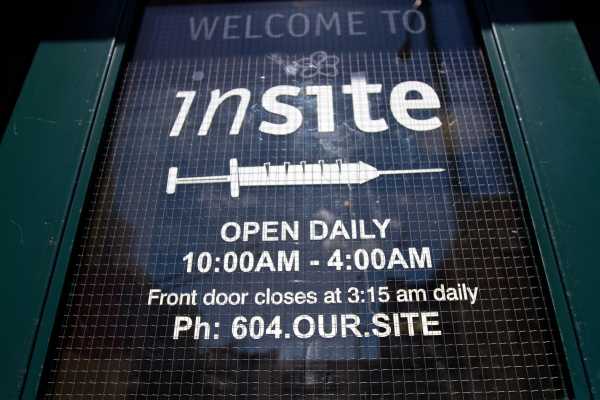

Finding the best ways to do good. Made possible by The Rockefeller Foundation.
What happens when traditional addiction treatments don’t stick, and people continue using dangerous opioids like heroin and illicit fentanyl anyway?
That’s the central question behind a huge report by the RAND Corporation. The review of the research looks at two harm reduction interventions that try to help people who aren’t in conventional treatment: prescription heroin and supervised drug consumption sites. Both approaches are used around the world — in Australia, Canada, and Europe — but are very controversial and have yet to earn official approval in the US.
Prescription heroin, called heroin-assisted therapy (HAT) in the RAND report, is a concept that may seem counterintuitive at first. At prescription heroin sites, people with opioid addictions are directly provided medical-grade heroin.
The idea: If some people are going to use heroin no matter what, it’s better to give them a safe source of the stuff and a safe place to inject it, rather than letting them pick it up on the street — where it could be laced with potent, dangerous fentanyl — and possibly overdose without medical supervision. Patients can not only avoid death by overdose, but otherwise go about their lives without stealing or committing other crimes to obtain heroin.
Supervised consumption sites take a tamer, but similar, harm-reduction approach. In these sites, people can use drugs with sterile injection equipment and the supervision of trained staff, who are ready with the opioid overdose antidote naloxone if anything goes wrong — and the sites may also link people to addiction treatment on request. Again, if people are going to use drugs anyway, the thinking goes, there might as well be a place where their safety can be guaranteed.
The report, the most comprehensive look yet at the research on both prescription heroin sites and supervised consumption sites, concluded that the research for prescription heroin is fairly strong, backed by randomized controlled trials (RCTs), which are the gold standard of scientific research. The evidence for supervised consumption sites, however, is much weaker, with only nine quasi-experimental studies available, and none of them particularly strong in methodology.
The findings come at a crucial time in the US. The opioid epidemic has fueled a huge spike in overdose deaths in recent years. There were more than 70,000 drug overdose deaths in the US in 2017 — a record for overdose deaths in a single year — and more than two-thirds of those deaths were linked to opioids.
We do have good treatments for opioid addiction, particularly medications like methadone and buprenorphine, which are shown to reduce the all-cause mortality rate among opioid addiction patients by half or more and do a far better job of keeping people in treatment than non-medication approaches. But the medications — and treatment in general — don’t work for everyone.
Prescription heroin and supervised consumption sites target the people conventional treatments don’t work for. The need for such approaches is especially acute today, as fentanyls, a class of synthetic opioids, slowly overtake heroin in the illicit market. Since fentanyls are so potent, and because people who use drugs don’t always know that they’re using fentanyls instead of heroin, the synthetic opioids have dramatically increased the risk of overdose in the past few years — becoming the single biggest cause of overdose in the US.
Harm-reduction approaches like prescription heroin and supervised consumption sites acknowledge the reality of continuing drug use and fentanyl exposure. If they work, they could save lives.
There’s good evidence for prescription heroin sites
Prescription heroin is absolutely not meant as a first-line treatment for opioid use disorder. In places where it has been deployed, it’s used as a treatment for people after more typical approaches, such as methadone, have failed. Estimates vary, but it’s generally estimated that 5 to 15 percent of people with opioid use disorder may benefit from prescription heroin.
That may not seem like a lot, but with roughly 1.5 million people using heroin daily or near-daily in the US, RAND noted that the approach could help tens of thousands of people. “Addressing a small proportion of an enormous problem can produce large benefits in absolute terms,” the report concluded.
The report found strong evidence that prescription heroin sites could, indeed, help people who have proven resistant to more traditional treatments. Previous studies, including RCTs, found that for this population there is “strong evidence that HAT reduces use of illicit heroin more than oral methadone does.” There were also “greater reductions in illegal activities or criminal justice involvement relative to those enrolled in oral methadone.” And participants “had significant improvements in physical or mental health,” although the benefits weren’t statistically better than control groups on methadone treatment.
Given that the research for methadone is so strong, the findings are very promising. But, again, this is all with the caveat that these studies apply only for a population who already tried other treatment approaches before moving to prescription heroin. So this is not a first-line approach.
The RAND report noted that the benefits have to be weighed with the risks. Heroin, after all, is more potent and, therefore, riskier than methadone and particularly buprenorphine. Even if prescription heroin sites produce benefits, then, there’s a chance they could still be worse on net when compared to traditional alternatives.
RAND pointed out, though, that prescription heroin sites typically involve supervision by trained medical staff. If someone does overdose, for instance, they can be quickly revived with oxygen or naloxone, greatly mitigating the risks.
Besides, RAND explained, the alternative here isn’t really methadone or buprenorphine. If these are people who previously tried such traditional treatments and couldn’t succeed in them, then the real alternative — the one that these people will go to without successful treatment — is illicit heroin or fentany, often used without any supervision whatsoever. That real alternative is undoubtedly riskier than a supervised prescription heroin site, even if heroin does carry some inherent risks. To this point, no one has ever died of an overdose at a prescription heroin site.
RAND concluded that prescription heroin sites are cost-effective, though it acknowledged that prescription heroin sites are more expensive than methadone treatment — about five to 10 times more — “mainly because of staffing requirements associated with supervising injections.”
Although some of the research in this area is strong, RAND found some gaps. There could be more rigorous work on prescription heroin sites’ community-level impacts, such as on public safety or broader drug use. And the research still hasn’t evaluated how such a site would work in the US in particular.
RAND’s report, at least, indicated it’s time for that to change. “Given the overall positive research on this, given the strong studies internationally, and given where we are in the United States with fentanyl overdoses in general, we think that in some places they actually should do some randomized controlled trials here in the US,” Kilmer, lead author of RAND’s report, told me.
To do that, though, researchers will need to find a way around legal barriers. Federal law currently considers heroin an illicit substance with no accepted medical uses — and that imposes hurdles to anything close to a prescription heroin site. So whether someone takes up RAND’s recommendation remains to be seen.
The evidence is much weaker for safe injection sites
Supervised consumption sites are intended for a much broader population than those who would benefit from prescription heroin — potentially reaching anyone who uses drugs for recreational purposes.
This, too, would face legal hurdles, not least because federal law prohibits maintaining sites where illicit drugs are used or distributed. But unlike prescription heroin, there’s some discussion about bringing supervised consumption sites to the US, including in New York, Philadelphia, and San Francisco.
Previous research has suggested it may be a good idea. Drawing on more than a decade of studies, the European Monitoring Centre for Drugs and Drug Addiction (EMCDDA) in 2018 concluded that safe injection sites led to “safer use for clients” and “wider health and public order benefits.” Among those benefits: reductions in risky behavior that can lead to HIV or hepatitis C transmission, drops in drug-related deaths and emergency service calls related to overdoses, and greater uptake in drug addiction treatment, including highly effective medications for opioid addiction.
But RAND put these studies under a closer microscope, and found serious gaps and flaws, concluding that the studies done so far are “limited in quality and location.”
Most of the studies came from the sites in Vancouver and Sydney, which diminishes the findings’ broader applicability. Most couldn’t adequately measure for the effects of the sites. And even those that did measure for such effects had fairly weak methodology.
“It’s not that you can’t learn anything from those studies,” Kilmer said. “But you have to be really careful.”
In the end, RAND found just nine studies out of 65 outcome-related articles that had quasi-experimental methods that could be considered somewhat rigorous. Since these studies are only quasi-experimental, and since they’re so few in number, it’s difficult to draw many definitive conclusions out of them. That’s especially true because all of these studies came from sites in just three cities — Barcelona, Sydney, and Vancouver — so the findings are also limited by population and geography.
“That was actually surprising to me: how few quasi-experimental studies had been done,” Kilmer said.
RAND also found several flaws in that research. For one, the studies often lacked a strong control group, which is needed to help tease out the effects of a supervised consumption site on its own. Several of the studies also used similar methodology and data as previous research, which could be problematic if other, perhaps more rigorous methods produced different findings. And none of the quasi-experimental studies looked at certain outcomes, including the possibility the sites extend drug-using careers or the sites’ ability to connect people with treatment.
Separately, there were some studies that attempted to use mathematical simulations to predict the effects of supervised consumption sites. But with such a weak research base behind them, RAND cautioned against making too much out of these simulations as well.
Still, the outcomes reported in the studies were generally neutral or positive, including lower overdose rates and fewer emergency calls related to overdoses, though there were some contradictory findings in regards to public disposal of syringes.
On the other hand, the studies didn’t find evidence that supervised consumption sites cause the problems that critics warn they will cause, such as higher drug use, whether locally or generally, and more crime. In fact, there has never been a fatal overdose at a supervised consumption site anywhere in the world. In that sense, these sites might be worth trying anyway since their potential downsides are so low, although whether they’re cost-effective is still an open question.
“We didn’t come across much literature suggesting that there were big downside risks to doing this,” Kilmer said. “Most of [these sites] have been around for 15 to 30 years, and they survived multiple changes in governments. And, look, we make it clear in the report that persistence doesn’t equate to effectiveness. But, on the other hand, if these supervised consumption sites had large downsides for the individual or the communities, it seems like we would know about that by now.”
The one risk may be political. When supervised consumption sites are proposed, they tend to suck up the entire discussion about drug policy because they’re so controversial. Under that context, it may be better to use political capital and financial resources on policies that are more proven. Otherwise, since the research is fairly weak, there’s a chance that a whole lot of debate and attention will go to an idea that ultimately doesn’t even work very well.
A big question for both approaches is scale
One potential concern for both prescription heroin sites and supervised consumption sites is just how well they scale. Since America’s opioid problem is so big, with millions of people affected, could there really be enough of these sites across the US to help everyone who needs them? And if setting up enough sites is impractical, just how valuable are these ideas even if the research supports them?
Kilmer suggested that this is less of a concern for prescription heroin. With only 5 to 15 percent of people with opioid use disorder likely to benefit from this approach, that’s a small enough portion of the population that it could be a matter of just setting up sites across the country, particularly in areas hard hit by opioids.
This is what Switzerland has done: There are currently 22 prescription heroin sites open across the country, two of which are in prisons. (Yes, Swiss prisons supply patients with heroin.) And the evidence, according to the RAND report, is that, if anything, demand is actually lower than the supply — although that comes with the big caveat that Switzerland has a smaller opioid problem than America, and doesn’t involve much fentanyl.
With supervised consumption sites, though, scale is a big problem. The RAND researchers offer some math to this point: With about 1.5 million people using heroin daily or near-daily in the US, and these individuals using on average twice a day, there are about 1.1 billion use sessions per year. Vancouver’s Insite facility, the largest supervised consumption site in the world, sees roughly 150,000 use sessions each year.
The RAND report concluded, “[T]his suggests that the United States would need more than 7,000 SCSs like Insite to supervise those use sessions; as of 2017, there were only about 100 SCSs operating worldwide.”
Canadian advocates and officials have tried to get around this problem by creating a more mobile version of supervised consumption sites — which can take the form of a tent or van deployed in an area hard hit by drug use and, according to RAND, “typically offer fewer services but focus on the core provision of supervision of injections, naloxone and oxygen administration, and calls to emergency medical services.”
The low cost and mobility of the more nimble approach may make it easier to deploy a lot of supervised consumption sites nationwide. But this approach has not been studied very well. And it’s possible that by sacrificing some services and a permanent physical location, the mobile sites are giving up some of the value of supervised consumption sites.
Beyond supervised consumption sites, the RAND report indicated that there are other ways to encourage supervision. If the key behind these approaches is that other people are quickly getting medical help when something goes wrong, then perhaps just getting more people to supervise each other in informal settings could do a lot of the work of supervised consumption sites without actually establishing them.
“There have always been public health campaigns in those communities about not using alone, but [we] could really be trying to hit that message home,” Kilmer explained. “We got campaigns like ‘friends don’t let friends drive drunk.’ You can imagine a potential campaign where it’s ‘friends don’t let friends inject alone.’”
Either approach shouldn’t happen alone
Even if prescription heroin or supervised consumption sites ultimately prove successful in the US, neither is going to be a silver bullet to the opioid epidemic. Instead, RAND argued that they should be taken as parts of a broader approach.
This is what experts have long said about the opioid crisis: It will require a suite of solutions, not one single change, to fully confront the crisis, including boosting access to treatment, reducing excess opioid painkiller prescriptions, adopting more harm reduction approaches, and tackling root causes of addiction, such as socioeconomic and mental health problems.
There’s still a lot of work to do in these other areas. For one, America could still do a lot more to boost access to more standard addiction treatment.
The decades of research into these medications show they work. When other places have expanded access to them, the results were impressive; in France, for example, the number of people in treatment rose and overdose deaths fell by 79 percent over the following four years after the government in 1995 relaxed rules on doctors prescribing buprenorphine.
But the medications remain inaccessible in much of the US. A 2016 surgeon general report found that just 10 percent of people with a substance use disorder get specialty treatment, in large part due to a lack of access to care. Even when specialty treatment is available, federal data indicates that fewer than half of treatment facilities provide medications like buprenorphine and methadone.
So for many places, Kilmer argued, “increasing access to buprenorphine and methadone should still remain our No. 1 priority.”
The US could also do more in other areas of harm reduction. Consider needle exchanges, where people can pick up sterile syringes and trade in used needles. The decades of research show needle exchanges combat the spread of bloodborne diseases like hepatitis C and HIV, cut down on the number of needles thrown out in public spaces, and link more people to treatment — all without enabling more drug use.
Yet needle exchanges remain scarce in the US. As Josh Katz reported for the New York Times: “According to the North American Syringe Exchange Network, 333 such programs operate across the country, up from 204 in 2013. In Australia, a country with less than a tenth as many people, there are more than 3,000.”
In some cases, America may also want to get more experimental, tapping into approaches that may not even be known yet. The RAND report, for example, noted that the early research on injectable hydromorphone — an opioid often used in legal painkillers — has found it to be a promising alternative to prescription heroin. Given that hydromorphone is likely going to carry less stigma than heroin, that could make it a suitable alternative for at least some patients or communities, particularly where prescription heroin sites will prove politically, socially, or legally unpalatable.
To this end, the RAND report speaks to how far America has to go. While other countries successfully try newer approaches like prescription heroin, the US is still figuring out how to expand basic access to medications like buprenorphine and methadone that have been around for longer and have even more evidence supporting them. Starting so far behind, the US may take years, as tens of thousands more people die to drug overdoses, to catch up.
Sign up for the Future Perfect guide to charitable giving. Over 5 days, in 5 emails, we’ll dive into questions like how much to give, where to give, and other ways to do good. Start here.
Sourse: vox.com






